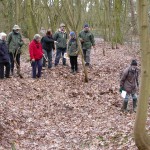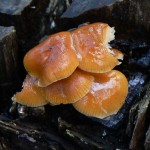On Saturday 20th February, Lesley Dunlop led a geology walk at Curridge near Newbury, at the boundary between the Reading beds, which are about 60 million years old, and the chalk, which is at least 20 million years older. There are numerous swallow holes at the lower edge of the Reading Beds, created when water flows through the acid sands and clays, then dissolves the alkaline chalk in the layers below. The first swallow hole was located conveniently close to the car park, next to the WI hall. The trees round the edge were leaning inwards, indicating that the hole had been growing within the lifetime of the trees. The clay and chalk were used in the local brickworks.
The walk started out across a grassy field. Exposed soil next to rabbit holes indicated that the field was on a sandy layer of the Reading beds. A muntjac deer was disturbed by dog walkers. The path then led steeply up through the woods, where the streams, ponds and wetness underfoot were clues to the underlying clay layer of the Reading beds. There were catkins on the hazels and the leaves of primroses and bluebells were beginning to appear. Dotted Border moths were floating on the surface of several of the woodland pools.
The track then went alongside the extensive Chieveley sand quarry workings. Sand Martin nest holes were visible in some of the exposed faces. The quarry sand was mostly pale in colour, but sections with a high iron content were stained red. The corpse of a Common Shrew was found on the path. Returning down the valley, the local bricks used in a farm house and its cottages were inspected. The cottages were mostly built with orange bricks. More expensive grey-glazed bricks were used for the front of the farm house, but the standard orange bricks were used for its sides and back.
As the lane approached the boundary between the Reading beds and the chalk, swallow holes began to appear in the woods at the side of the road. The bright orange Velvet Shank fungus Flammulina velutipes was spotted at the base of a tree stump. A track then led out across the fields, with the beginning of the chalk indicated by a change from grass to arable land. Looking down the valley towards Newbury, Lesley pointed out the rough ground above Red Farm where the overlying London Clay has formed a landslip over the Reading Beds.


